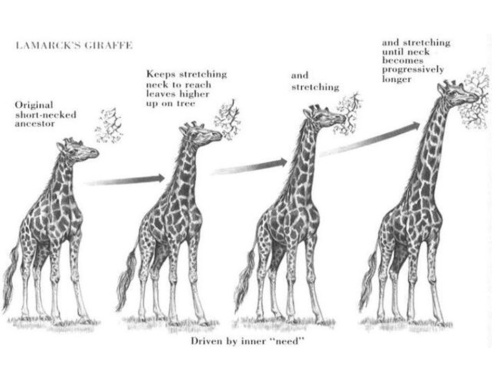This is the first of a series of posts about evolution and theology. I am in part undertaking to write this series as a way to inspire myself and practise writing about this subject for my MTh thesis.
The Idea of Evolution
The idea of a progressive transformation of species is older than Darwin. The idea of some sort of evolution of species has been around in Europe before Charles Darwin. Darwin’s grandfather, Erasmus Darwin, speculated about evolution and published his proposals in Zoonomia, or, The Laws of Organic Life (PDF available from Project Gutenberg)in 1794. In 1844 Robert Chambers published a his views anonymously in the Vestiges of the Natural History of Creation (PDF available at archive.org). The French biologist Jean-Baptiste Lamarck proposed a mechanism of “transformation” almost sixty years before Darwin’s Origin of the Species. For Lamarck, the two components of evolution were the influence of the environment and the efforts of the animals themselves. For example, giraffes got long necks because generations of giraffes stretched their necks to reach high branches.

Lamarck’s Giraffes
The work of August Weismann proved that only the sexual cells had hereditary powers and thus disproved Lamarck’s idea. Herbert Spencer proposed an evolutionary theory just prior to Darwin’s publication. Spencer was the first to use the term so often associated with Darwinian evolution: “survival of the fittest”. Charles Darwin coined the term “natural selection”, as opposed to artificial selection, which is the process whereby humans breed animals for their own needs. In 1900 the work of Mendel in genetics was rediscovered and paved the way for Darwinism and neo-Darwinism.
What is Evolution?
Let’s start with the basics. Evolution is a scientific theory of the history of biological life. The level at which evolution works is that of the population. A single individual cannot evolve, but a population of individuals can. Evolution can occur in a number of ways: mutations (random genetic changes, like a slightly longer tail), random changes in genetic frequencies (genetic drift, where by chance some individuals do not reproduce), migration (gene flow, when a population moves to a new habitat, taking their genetic information with them to the new environment). Individuals who reproduce take part in evolution. Survival is not enough, the individual must successfully reproduce.
Below are a couple of key words and definitions to start off with:
Extinction occurs when an entire species dies out. It is an essential part of the evolutionary process and facilitates the evolution of new species.
Adaptive radiation refers to the origin of new species from a common ancestor, e.g. as a result of migration or changes in habitat. A clue in adaptive radiation is the shared traits of the derived species, also called homologies. Examples of homologies are the flippers of whales and dolphins. Universal homologies are shared traits that occur in all life-forms. These universal homilies are the way cells are put together, the way ATP works at the cellular level and the way the genetic code works.
As opposed to homologies, analogies are similar structures that aren’t a result of shared ancestry.
Exaptations are features that were initially used for a certain purpose, but later became used for something else.
Vestigial traits or organs are features that no longer serve a function or serve only a very reduced function. Examples of vestigial organs are the human coccyx and the eyes of the blind cave-dwelling fish Astyanax mexicanus.
Transitional forms are organisms that are intermediate between two major groups, for example between fish and amphibians or reptiles and birds. Probably the most famous of these is archaeopteryx. In a sense all forms are transitional forms, because evolution is a dynamic process that is continually occurring.
Speciation is when a new species arises through evolution. A necessary factor for speciation is that the two or more forms that have become separate species cannot produce offspring that can reproduce (think of a mule). Geographical or allopatric speciation happens when a population is divided by some natural barrier (e.g. glacier, arm of the sea, mountain) and continue to develop in different directions. Sympatic speciation occurs in the same environment. This kind of speciation occurs when the first differences between the two species prevent them from breeding. The barriers of breeding might not always be because of sterility, but because of behavioural differences.
Bibliography:
Cotner, S & Moore, R 2011. Arguing for evolution: An encyclopedia for understanding science. Greenwood: Santa Barbara.
Durant, J (ed.) 1985. Darwinism and divinity: Essays on evolution and religious belief. Oxford: Basil Blackwell.
Montenat, C, Plateaux, L & Roux, P (eds.) 1985. How to read the world: Creation in evolution. London: SCM Press.
Pennock, R T 2002. Tower of Babel: The evidence against the new creationism. Cambridge: MIT Press.
Rice, S A 2007. Encyclopedia of evolution. New York: Facts on File.
Zimmerman, P A 2009. Darwin at 200. Concordia Theological Quarterly 73, 61-75.

Very well done. Can’t wait to read the next one
LikeLike
Thank you 🙂
LikeLike
This is a good informative video that explains how evolution works.
LikeLike
On what are you doing your MTh? I am studying ecology at the moment, but have always had a lively interest in evolution.
LikeLike
My MTh is in the field of dogmatics and takes a look at how the theory of evolution can be a positive thing for theology.
LikeLike